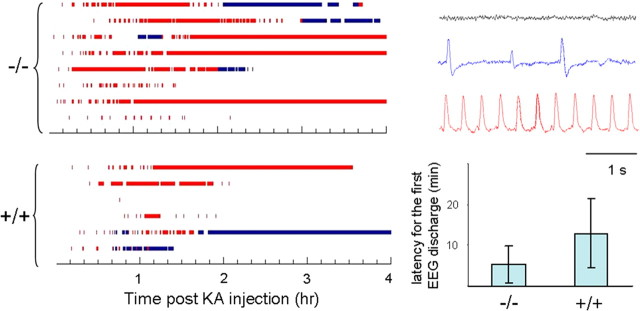Figure 4.
Higher seizure susceptibility in Zip-1,3 −/− mouse brain. Summary data quantifying shorter latency to seizure onset and prolonged time spent in active seizure activity in mutant compared with controls injected with kainic acid. EEG seizure activity recorded from mice (−/− n = 8; +/+ n = 6) injected with KA (15 mg/kg). Before injection, Zip1,3 mice show normal EEG patterns (right, gray sample trace) without any spontaneous cortical discharge activity similar to wild-type mice. After injection of KA, behavioral and electrographic seizure activity gradually developed over 30 min (blue and red sample traces). As shown at left bottom, the average latency for the initial onset of high-frequency EEG spiking was 11 ± 9 min in the −/− group, which is less than one half that in the +/+ group (26 ± 17 min, p = 0.05). Blue bar marks the time during which the EEG shows low-frequency (<1 Hz) aberrant synchronized spike discharges (blue sample trace) Red bar indicates the period of high-frequency synchronized EEG seizure discharges (red sample trace). By comparison of measures of latency to seizure onset and total time spent in seizure activity, Zip-1,3 −/− mutants exhibit higher seizure susceptibility to the KA injection than their +/+ littermates.

